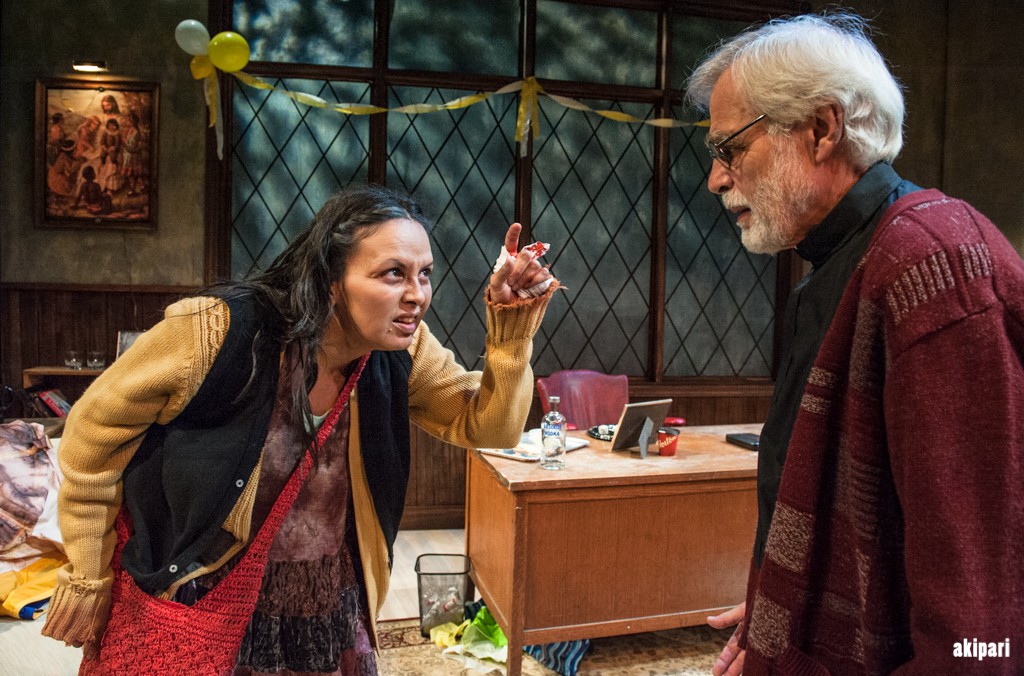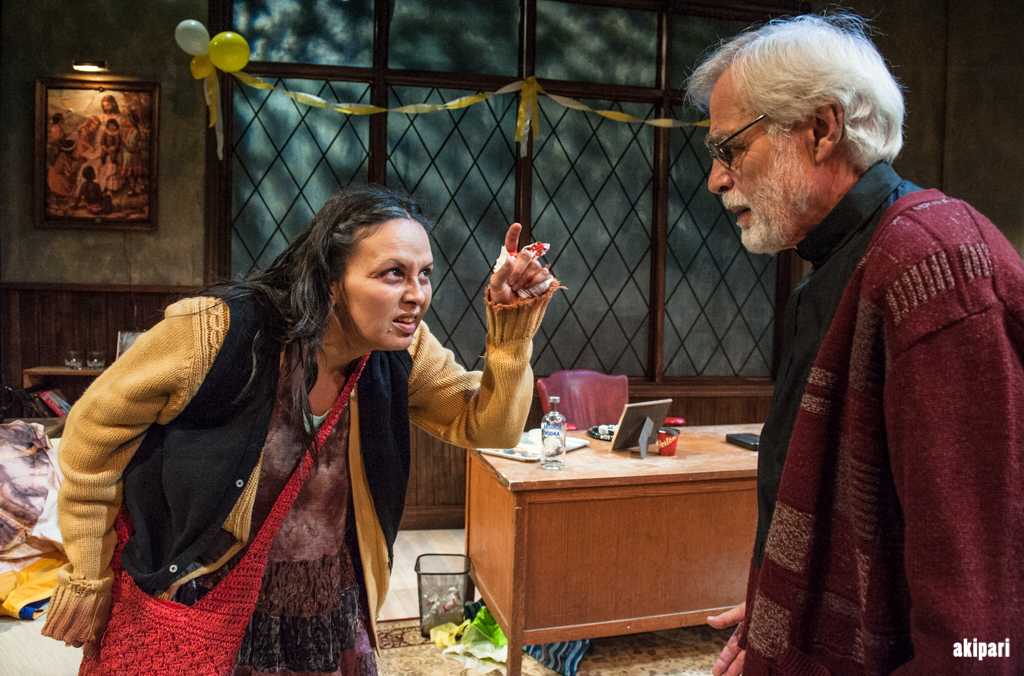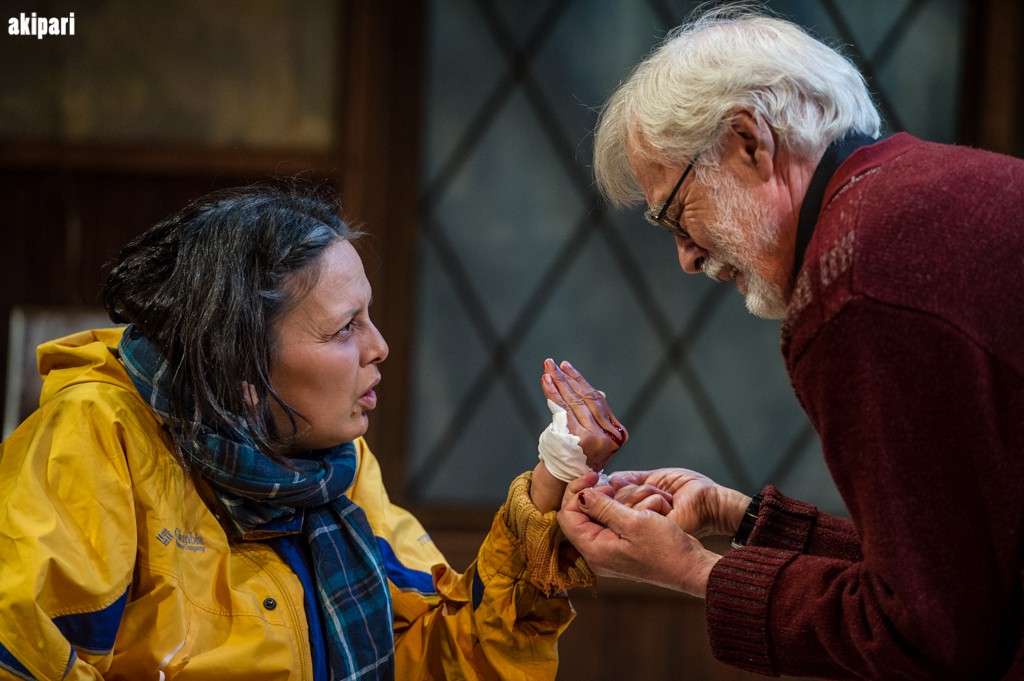GOD AND THE INDIAN: CONFRONTING THE PAST, HEALING WITH HUMOUR
God and The Indian centres around two characters who share a dark past together in a major portion of Canadian history. Johnny, a Cree woman, is shocked to recognize one of the priests from her time in a residential school while she is panhandling her way on the streets. She follows the priest, George King, to his office to confront him about the terrible abuse she and other children endured at the school.
The play opens by introducing King(Thomas Hauff) as a lighthearted priest with an optimistic view of life, who presently lives comfortably with his wife and children. King at first glance is likeable to the audience, that is until Johnny Indian(Lisa C. Ravensbergen), enters the picture. She is a woman with a troubled past. That troubled past she hints at includes him. This is where the magic of God and The Indian starts, its simple in its two person set up, yet the dialogue to two share are intricately layered with humour and darkness. It’s like a game. Johnny Indian is the master at the art of implying, hinting to King that it was he who sexually abused her before outright saying it. King also masters the art of denial…or does he? You can’t tell. Ravensbergen does an haunting job at portraying Johnny Indian, a ghost of her former self, as she emotionally recollects how her life was tragically taken away from her in a school where the goal was to “kill the indian; save the child”. Hauff is convincing as a priest trying that seemingly wants to help her and is also sorry about taking a small part in the process. Although he was at the school, he vehemently denies the abuse she speaks of.
Natives tend to use humour as a healing mechanism, which playwright Drew Hayden Taylor incorporates into Johnny Indian’s dialogue.
If you want to learn about the how the Indigenous population was affected by residential schools, God and the Indian is a good place to start. This play is not only educational in its premise, but also moving with its dialogue and performances. God and The Indian is written by Ojibwe playwright Drew Hayden Taylor, an accomplished contemporary storyteller who is responsible for producing numerous plays dating back to 1989 and specializes in creating Native literature. 
Here we have Ravensbergen talk about the essential role that productions like God and The Indian play in educating society about residential school horrors, their aftermath and how we can heal from it as a society.
How did you prepare for the role?
I still am; I’m not sure that one can fully prepare to tell a lived-story. At best I feel that my job as an actor is to continue to be open to the clues around me that resonate with my character’s world – past and present – and maintain open eyes to a reality that, to be quite honest, is not my day-to-day reality. Many “Johnnys” have crossed my path in the neighbourhoods we’ve been rehearsing and performing in… and they have enriched the story that she (Johnny) inhabits within me. That, and meditation helps; I’m grateful for all the grounding I can get with this show.
God and The Indian touches on the residential school system and its aftermath. From an Indigenous standpoint, how would you have liked to see the government redeem themselves for how they treated indigenous people?
I don’t know how to even begin to answer this question. How can any word(s) justify or contextualize such a ‘mistake’? How does any government redeem themselves from enacting and colluding with others to enact genocide? It’s one of the hallmarks of privilege that governments (and others) can ‘get over it’ and ‘move on.’ The government isn’t even one generation away from the policies that initiated the residential school system; the mindset of ‘saving the child by killing the Indian’ is still fresh in our federal mindset and country’s bones. Similarly, actions always speak louder than words: burn and ban existing history books and literature that hides the truth of who perpetrated these policies, laws, and abuses. Re-write the history books and national school curriculum to tell the full story along with self-initiated systemic change from the government-down – which ultimately, reflects and demands a foundational dismantling of power as we know it. Small things like that might begin to help.
Do you believe plays like God and The Indian do a good job at educating society about what North-American Natives went through in residential schools? And how?
I think shows like this are essential for those who need the educating, but I wonder if those people are actually coming to this show, and others like it? So, the more interesting question to me is, how do we collectively – as media and artists – invite those who need educating to enter into a space of actual learning? I think learning involves a certain amount of change, in that to absorb new information, you replace old information, or at least, you make space inside yourself for new information to root and grow… evolve. And part of what I love about theatre, is that it’s a calling to a middle ground where I as an actor bring what I know of this particular story, and the audience brings whatever their knowledge is and we join together for an hour and a half to have a conversation. During this time, the audience is invited to be open to new truths and/ or to affirm their own. If people walk out of the theatre changed “even just a little bit,” as Johnny says, then maybe… just maybe… we can start to see real change that goes beyond individuals and political agendas. But people have to be willing to actually change. That takes courage and some (or lots of) work… on everyone’s part.
If you got to write an Indigenous based play what would your premise be?
There is no ”if”! I have and I am… in the midst of two new pieces: The World is the World is a theatre/dance collaboration with Michael Greyeyes and Billy Marchenski, about the things we cannot bear, but carry anyway. Another project is called The Seventh Fire, which I developed most recently through a playwriting residency at Playwrights Theatre Centre. The Seventh Fire is filmic in nature, mythic in proportion, and sources traditional stories and societal roles as a way to explore myth in the everyday. Set in the present, past, and future, it tells the story of a broken woman’s return to the Ojibwe community she has never known. She discovers her destiny is tied to prophesy as she becomes pivotal to the survival of a People who have rejected her.
What inspired you to get into acting?
It took me awhile to be in the place I am now. My heart is called by many things, so I feel like theatre is that perfect storm of a lot of different passions coming together and having expression. Some of those being: understanding what is beneath the surface of a person, of a moment, of a story, and of a land. I’m compelled by what makes the invisible, visible.
What struggles do you think that Aboriginal artists like actors face today?
Being seen. Period. Having a legitimate voice – not just a token one – and therefore contributing equally and equitably to being something other than what is perceived on the surface.
How do you think as a society we will overcome these struggles?
Do you think we are capable of overcoming such things? My concern is that the everyday Canadian living their privileged life in mainstream society – that has little to no direct relationship with what happened at the residential schools – will mistake the word ‘Reconciliation’ for Assimilation. And so the cycle will continue. And so people like me, and others who are even more deeply connected to that harrowing journey, will continue to be asked and expected to educate and eradicate a self-imposed ignorance that, to be frank, is not ours.
God and the Indian runs from May 6 – 17 at The Native Earth Performing Arts. Tickets can be purchased here.



